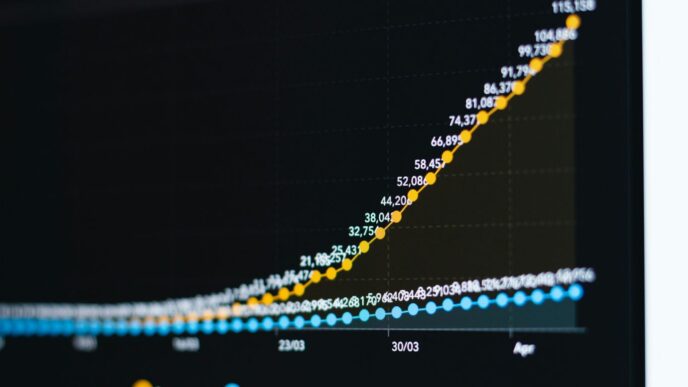The recent antitrust ruling against Google by the Department of Justice (DOJ) is a pretty big deal. It’s been a long time coming, and it’s got a lot of people in the tech world talking. Basically, the government argued that Google has been too dominant for too long, using its power to keep competitors down. This whole saga has pulled back the curtain on how search engines and online ads really work, and now everyone’s wondering what happens next. It’s not just about Google; this could change things for a lot of other big tech companies too.
Key Takeaways
- The DOJ argued that Google illegally maintained its monopoly in search and advertising by using exclusionary tactics, like paying to be the default search engine on many devices.
- The court found Google to be an illegal monopolist, agreeing that it abused its market power to keep competitors out.
- While a full breakup of Google wasn’t ordered, the ruling prohibits exclusive default search engine contracts and requires some data sharing with rivals.
- This case signals a tougher stance on big tech regulation, potentially setting a precedent for future antitrust actions against other major technology firms.
- The market reaction was somewhat muted, but the long-term implications for competition, innovation, and business practices in the tech industry are significant.
The Landmark DOJ Antitrust Case Against Google
So, the big news is that the Department of Justice, along with several states, took Google to court. They basically said Google has been acting like a monopoly, especially with its search engine and all the ads that come with it. This whole thing is a pretty big deal because it’s one of the first major antitrust cases against a tech giant in a long time. The government’s main argument? That Google has been using its power to keep competitors out of the picture. It’s all about Section 2 of the Sherman Antitrust Act, which is the law that stops companies from being bullies in their market. They’re saying Google didn’t just get to the top because its product is good; they actively made it hard for anyone else to even get a foot in the door.
Google’s Alleged Monopoly Power in Search and Advertising
The core of the DOJ’s complaint is that Google has a stranglehold on two main areas: search and search advertising. We’re talking about Google having over 90% of the search market. That’s a huge chunk. And it’s not just about people typing into a search bar; it’s also about the massive advertising business that’s built around those searches. The government argues that this dominance isn’t natural. They claim Google has been actively working to keep it that way, making it super tough for any other search engine or ad platform to get a real chance to compete. It’s like they’ve built a fortress around their market share.
The Sherman Antitrust Act: Section 2 Focus
This whole legal battle is really centered on Section 2 of the Sherman Antitrust Act. This part of the law is all about stopping single companies from acting like monopolies and abusing their power. The DOJ is pointing fingers at Google, saying they’ve used their dominant position to shut down competition. It’s not about Google and other companies making a deal to limit competition (that would be Section 1), but about Google acting alone to keep its dominance. This focus is important because it shows how regulators are looking at the power of individual tech companies and what they can do about it. The outcome here could really change how these big tech companies are regulated going forward.
Exclusionary Tactics: Default Search Engine Deals
One of the main ways the DOJ says Google has been acting like a monopoly is through its deals to be the default search engine. Think about your phone or your web browser. Most of the time, Google is already set up as the default search engine. The government argues that Google has paid big money, like billions of dollars, to companies like Apple to make sure Google Search is the automatic choice for users. They also have similar deals within the Android system. The DOJ says these exclusive contracts are like a wall, preventing competitors from getting the exposure they need to even be considered by users. It’s a way to lock people into using Google without them even having to think about it, which makes it really hard for rivals to gain any traction. This is a key part of the DOJ’s lawsuit against Google.
Key Revelations from the Google Antitrust Trial
The antitrust trial against Google wasn’t just about legal arguments; it pulled back the curtain on how the search giant actually works. For years, people in the SEO world and beyond have speculated about Google’s inner workings, and this trial brought some of that speculation into the light. It was pretty wild to see sworn testimony and internal documents confirm things that were previously just educated guesses.
Insights into Ranking Systems and User Clicks
It turns out, user clicks are a pretty big deal for Google’s search results. The trial revealed how systems like NavBoost use information from user interactions to help decide what shows up first. This confirmed that what users actually click on matters a lot in shaping search rankings. It’s not just about keywords anymore; it’s about what people find useful enough to engage with.
The Role of Freshness and Machine Learning
Google also shared details about how it handles timely information. They have a system called “Instant Glue” that looks at user activity over a 24-hour period to quickly boost fresh content. This means that for searches where being up-to-date is important, Google tries to show the newest stuff right away. Machine learning models, like RankBrain and BERT, are used to fine-tune results and better understand what people are actually asking for, rather than being the main engine driving everything. It’s more like a final polish.
Context and Personalization in Search Results
What really stood out was how much Google relies on context and personalization. Your location and your past search history play a huge role in the results you see. This means that the classic
The Verdict: Google Found to Be an Illegal Monopolist
So, the judge dropped the hammer. In August 2024, the court officially ruled that Google has been illegally holding onto its monopoly power. This wasn’t just a slap on the wrist; it was a clear statement that the company has acted like a monopolist to keep its dominant position.
Judge Mehta’s Ruling on Monopoly Maintenance
Judge Amit P. Mehta laid it out pretty plainly: "Google is a monopolist, and it has acted as one to maintain its monopoly." The case really dug into how Google uses its search dominance to stay on top. It’s not just about having a good product, but about how the company actively works to keep competitors out. This ruling is a big deal because it acknowledges that Google’s market position isn’t just natural; it’s been actively managed to prevent others from getting a foothold. Google, of course, disagrees with this finding and is planning to contest the ruling contesting this ruling.
Targeted Behavioral Remedies vs. Breakup
Now, what happens next? The Department of Justice wanted to break Google up, maybe even sell off parts like the Chrome browser. But Judge Mehta decided against a full breakup. Instead, the focus is on specific changes to how Google operates. Think of it like this: instead of chopping up the whole company, the judge is telling Google to change certain behaviors that are causing problems.
Prohibition on Exclusive Default Contracts
One of the biggest takeaways is that Google is now banned from paying for exclusive deals to be the default search engine. This means companies like Apple and phone manufacturers can’t just take Google’s money to ensure their devices send users to Google Search by default. This is a pretty significant shift, aiming to open the door for other search engines to get in front of users. The court also mandated that for five years, Google has to share some of its search data and user interaction information with competitors. This is meant to give rivals a better chance to compete and improve their own services.
Potential Remedies and Their Industry Implications

So, what happens now that Google’s been found guilty of monopolistic practices? The big question is what the court will actually do about it. While some folks might imagine a dramatic breakup of Google, like splitting up its search engine from its ad business, that’s probably not on the table. It’s a pretty extreme measure, and honestly, it’s not clear how it would even work in practice for a company like Google.
More likely are changes that aim to open things up a bit. Think about ‘choice screens’ – those pop-ups you might see when setting up a new phone or computer, asking you which search engine you want to use. This would give smaller search engines a real shot at getting in front of users. Another big one is stopping Google from making exclusive deals, like the one that makes it the default search on iPhones. This would stop Google from using its deep pockets to lock out competitors.
Here are some of the remedies being discussed:
- Choice Screens: Requiring operating systems and browsers to offer users a selection of search engines.
- Prohibition of Exclusive Deals: Banning agreements that make Google the default search engine on devices or platforms.
- Data Sharing Mandates: Potentially requiring Google to share certain data with competitors, though this is a complex area.
These changes could shake things up for Google’s partners, who currently get paid to be the default. If those deals are banned, those payments stop. It’s a bit ironic, but some analysts think that even with these remedies, Google might still end up in a strong position, maybe even saving money by not having to pay for default placement. It’s a complicated dance, and the real impact will take time to unfold.
Broader Context of Antitrust Enforcement
This whole Google antitrust situation isn’t happening in a vacuum, you know? It really feels like we’re seeing a shift in how the government is looking at big tech. For a long time, it seemed like these companies could do pretty much whatever they wanted, especially in the digital world. But this case, and others like it, suggest that regulators are getting more serious about making sure things stay fair.
A New Era of Aggressive Tech Regulation
It’s like a wake-up call for the industry. The government is showing it’s willing to take on these massive companies. This isn’t just about Google; it’s a signal to others too. We’re seeing a move away from the more hands-off approach of the past. This could mean more scrutiny for companies like Apple and Meta down the line.
Precedent for Future Cases Against Tech Giants
What happens with Google could set the stage for how other big tech antitrust cases are handled. Think about the old Microsoft antitrust case from the 90s. That really changed things for a while. This Google ruling might do something similar, potentially reshaping how competition works in the tech space. It’s a big deal because it could influence how companies operate and how they deal with competitors. The court’s decision that Google illegally maintained its monopoly could lead to new rules for monopolies.
Comparison to the Microsoft Antitrust Case
People keep bringing up the Microsoft case from the late 90s. Back then, Microsoft was accused of bundling its web browser, Internet Explorer, with Windows to crush competitors. The outcome led to a period where Microsoft had to change its ways and competition in the browser market opened up. This Google case feels similar in that it’s about a dominant company using its power to keep rivals out. The big question is whether the remedies will be as impactful this time around. It’s a complex situation, and the remedies could range from things like:
- Requiring Google to offer users a choice of search engines when they set up new devices.
- Banning exclusive deals that make Google the default search engine on phones and other gadgets.
- Potentially imposing fines, though the exact amount is still up in the air.
It’s going to be interesting to see how these remedies play out and if they actually level the playing field or if Google finds ways to adapt and maintain its dominance. The whole thing is a pretty big deal for the future of the internet and how we all find information online.
Market Reaction and Future Outlook
So, what does all this mean for Google and the rest of the tech world? It’s a bit of a mixed bag, honestly. After the big ruling in September 2025, Alphabet’s stock did a pretty good jump – like, 9% in a single day. Investors seemed to breathe a sigh of relief that Google wasn’t going to be chopped up into little pieces. Analysts even bumped up their price targets, thinking Google could handle whatever came next.
But here’s the thing: that initial excitement might be a bit premature. Even though the court didn’t force Google to sell off Chrome or Android, there are still some significant changes coming. Google has to share its search data with competitors, which could really shake things up, especially with AI becoming such a big deal in search. Plus, there’s another big DOJ case coming up about Google’s ad tech business, and that verdict in October 2025 could bring even more restrictions.
It’s also interesting to see how different countries are handling this. The U.S. went the route of a big lawsuit, while Europe has been more direct with rules like the Digital Markets Act. This means Google has to play by different sets of rules depending on where it operates, which can’t be easy.
Here’s a quick look at how things might shake out:
- Potential Remedies: While a full breakup is unlikely, expect things like ‘choice screens’ where users pick their default search engine. Google also can’t make exclusive deals that lock out rivals as easily.
- Financial Impact: Google’s core business is still strong, with good revenue growth and profit margins. However, the new rules and potential fines could put some pressure on those numbers.
- The AI Factor: Google is betting big on AI to stay ahead. The court even mentioned that AI could be the thing that disrupts Google’s dominance. So, how well they integrate AI into their products will be key.
Looking ahead, a lot depends on what happens in the upcoming U.S. elections and how regulators worldwide continue to approach these tech giants. It feels like we’re entering a new phase of tech regulation, and companies like Google will have to be really smart and adaptable to keep thriving. It’s not just about winning one lawsuit; it’s about figuring out how to operate in a world where the rules are changing.
So, What’s Next?
Alright, so the dust is starting to settle after this whole big court case between the DOJ and Google. It’s been a long road, and while Google didn’t get completely broken up – which some folks thought might happen – the court did say they’d been playing unfairly to keep their top spot in search and ads. This means things are going to change. Google can’t just pay to be the default search engine on phones and computers anymore, and they have to share some of their search data with competitors. It’s not a total loss for Google, but it’s definitely not a free pass either. This ruling is a pretty big deal for how tech companies operate going forward, and it shows that even the biggest players have to follow the rules. We’ll have to wait and see exactly how Google adjusts and what this means for other tech giants, but one thing’s for sure: the game has changed a bit.
Frequently Asked Questions
What was the main accusation against Google in this antitrust case?
The U.S. government accused Google of being a monopoly. This means they said Google had too much control over the search engine and online advertising markets. The government also claimed Google used unfair tactics, like paying companies to make Google the automatic search engine on their devices, to keep competitors out.
What does the Sherman Antitrust Act have to do with this case?
The case heavily relied on Section 2 of the Sherman Antitrust Act. This law is designed to stop companies from abusing their power to control an entire industry. The government argued that Google used its strong position to unfairly shut out other search engines and advertisers.
What did the judge decide in the end?
The judge agreed with the government that Google is a monopolist and has acted like one to keep its dominant position. However, the judge decided against breaking up the company. Instead, Google was told it can’t make exclusive deals to be the default search engine and must share some of its search data with rivals for a period.
What are ‘choice screens’ and why are they being discussed?
A ‘choice screen’ is a pop-up or setting that would let users pick their preferred search engine when they first set up a new device. The idea is to give other search engines a better chance to be used, rather than Google being the automatic default everywhere.
How is this case similar to or different from the old Microsoft antitrust case?
Both cases involved powerful tech companies accused of using their dominance to stifle competition. Microsoft was accused of unfairly bundling its web browser with Windows. This Google case focuses more on exclusive deals and how Google maintains its search engine and advertising power. Both cases show regulators trying to ensure fair competition in the tech world.
What does this ruling mean for other big tech companies?
This ruling sends a strong message to other large tech companies. It shows that governments are serious about enforcing antitrust laws against them. It might lead to more investigations and stricter rules for companies like Apple, Meta, and Amazon in the future, encouraging them to be more competitive.














